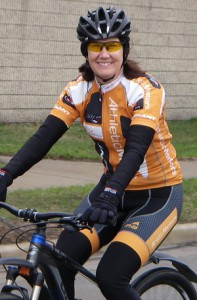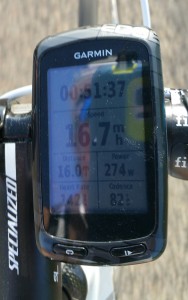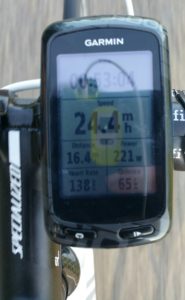–By JoAnn Cranson, Team OAM NOW cyclist
The first time another rider asked me, “What kind of watts were you pushing up that hill?” I had no idea what they were talking about. I knew speed, cadence, heart rate, distance… but watts? How would I know my watts? Then, I was introduced to an incredible tool for cycling – the power meter. If you haven’t used one yet, I will warn you… once you start, you become lost without it, like so many new technologies.
If you are like I was, you may have no idea what a powermeter is. I’ll try to explain in layman terms. Power meters measure torque and velocity to calculate power in watts. In other words, the force you use to push your foot against the pedal and how fast you can turn the crank equals the power (wattage) you create.
Power meters come in many different styles and options. You can spend between $500 to almost $4000, depending on what your goals are and what you are willing to invest. They can be installed in the crank set, rear hub, bottom bracket, chair ring and now pedals too. Because they are wireless, they instantly display the wattage on your cycling computer, providing instantaneous feedback throughout your ride. Naturally it takes some time to determine what works best for you and to make sure everything involved is compatible.
Now that you know what a powermeter is, you may ask “What good does a powermeter do”? Is it just another fancy gadget you have to figure out how to work?
In my opinion, it’s more valuable to me than my speedometer or heart-rate! I remember I use to not want to go ride when it was really windy or a hilly ride because I got discouraged with my average mph. Well, with the powermeter it doesn’t matter how windy it is, my power is going to show me how hard I’m working whether I’m going 16.7 mph or 24.4 mph.
I took a couple pictures of my cycling computer on a windy day to show the differences. Notice it shows my power vs mph (depending on if I had a head-wind or tail-wind).
The power meter is an incredibly valuable tool for so many reasons. It measures your workload accurately and instantaneously whereas heart rates respond more slowly and are more effected by outside influences such as temperature and hydration. Post-ride data analysis allows you to review power over time so you can see strengths and weaknesses. For example, you can see from the data that you are stronger when you ride at a lower cadence, or that you climb best when you stay seated at a high cadence.
Not only can you determine your strengths and weaknesses, but you are able to individually tailor your training using power. Whether you are doing road racing, time trials, or want to stay with the faster group rides, a power meter will help you get the most out of your training every day. For example, if you want to be consistent in long rides, you can practice intervals above/under your threshold values so you can teach your body to handle it. You can learn through training what wattage you can handle before “blowing up” over a specific time period. And my favorite part is that you can clearly see as you train how your wattage continues to climb as you get stronger!!
One final and very important benefit of training with power is the ability to see clearly when you are overtraining. If you have been riding a consistent wattage and all of a sudden your heartrate is elevated but you can’t hold the watts… it’s a clear indicator that you are over-training and you need rest. This was always the hardest thing for me to see in myself before I had a power meter.
As a rider who went from “what is a power meter” to “I can’t ride without a power meter.” – I can tell you that a power meter is a great tool to improve your individual cycling no matter what type of rider you are.













